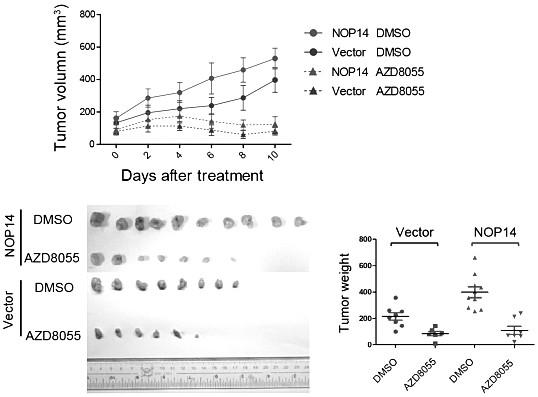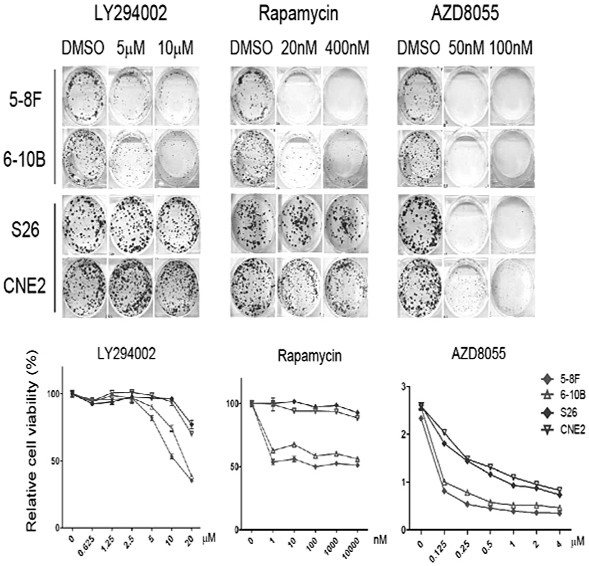Application of nop14 gene and its protein as a marker of tumor sensitivity to mTOR inhibitors
An inhibitor and gene technology, applied in the field of biomedicine, can solve the problem that the anti-tumor efficacy of mTOR inhibitors varies from person to person, the narrow application range of rapamycin and its derivatives, and the unsatisfactory effect of rapamycin drugs, etc. problem, to achieve the effect of inhibiting the ability of cloning formation, promoting individualized treatment, good application value and prospect
- Summary
- Abstract
- Description
- Claims
- Application Information
AI Technical Summary
Problems solved by technology
Method used
Image
Examples
Embodiment 1
[0036] Example 1 The expression of NOP14 is regulated by mTORC1
[0037] 1. Experimental materials
[0038] (1) Drug: mTORC1 inhibitor rapamycin (rapamycin, chemical formula: C 51 h 79 NO 13 , CAS number: 53123-88-9), S6K inhibitor PF-4708671 (chemical formula: C 19 h 21 f 3 N 6 , CAS number: 1255517-76-0), mTORC1 and mTORC2 co-inhibitor AZD8055 (chemical formula: C 25 h 31 N 5 o 4 , CAS number: 1009298-09-2), and the PI3K inhibitor LY-294002 (chemical formula: C 19 h 17 NO 3 , CAS number: 154447-36-6)
[0039] (2) Cancer cells: nasopharyngeal carcinoma cell lines.
[0040] 2. Western blot analysis of the regulation of NOP14 by the PI3K-mTOR pathway
[0041] Add mTORC1 inhibitor rapamycin at a final concentration of 1 μM, S6K inhibitor PF-4708671 at a final concentration of 10 μM, and co-inhibitor AZD8055 of mTORC1 and mTORC2 at a final concentration of 0.1 μM to the adherent cells , and the PI3K inhibitor LY-294002 at a final concentration of 10 μM for 24 hour...
Embodiment 2
[0045] Example 2 Western blot analysis of the effect of NOP14 on Akt activation
[0046] 1. Experimental materials
[0047] (1) Reagents: pLVX-puro empty vector plasmid and pLVX-NOP14 plasmid; pLKO.1 plasmid, the control shRNA sequence is 5'-CCTAAGGTTAAGTCGCCCTCG-3', the No. 1 shRNA sequence targeting NOP14 is 5'-CGGGAATGGTCTGTGTGTTAT-3' , No. 2 shRNA sequence is 5'-GCTATTTCCAACTTCCGACTT-3'; transfection reagent PEI; opti-MEM medium; puromycin.
[0048] (2) Cancer cells: CNE1, HNE1 cell lines
[0049] 2. Western blot analysis of the effect of NOP14 expression on Akt activity
[0050] (1) Construction of NOP14 overexpression and knockdown cell lines
[0051] Add 7-8 μg of pLVX-puro empty vector plasmid, pLVX-NOP14 plasmid or pLKO.1 plasmid containing control shRNA sequence, No. 1 and No. 2 shRNA sequences targeting NOP14 to 1 ml of opti-MEM medium, and Mix 21 micrograms of PEI and incubate at room temperature for 15 minutes; add the above mixture to CNE1 or HNE1 cells in a ...
Embodiment 3
[0057] Example 3 Tumor cells overexpressing NOP14 are sensitive to mTOR inhibitors in nude mouse tumor formation experiments
[0058] 1. Experimental materials
[0059] (1) Drugs: common inhibitors of mTORC1 and mTORC2 AZD8055, dimethyl sulfoxide (DMSO)
[0060] (2) Cancer cells: CNE1 cell line transfected with pLVX-puro empty vector plasmid or pLVX-NOP14 plasmid in Example 2
[0061] (3) Commercially purchased nude mice
[0062] 2. Experimental grouping
[0063] (1) Empty vector control group: blank control, CNE1 cells (Vector cells) transfected with pLVX-puro empty vector plasmid were treated with DMSO.
[0064] (2) Empty vector AZD8055 group: Vector cells were treated with AZD8055.
[0065] (3) Overexpression control group: CNE1 cells transfected with pLVX-NOP14 plasmid (NOP14 cells) were treated with DMSO.
[0066] (4) AZD8055 overexpression group: NOP14 cells were treated with AZD8055.
[0067] 3. Sensitivity of NOP14-overexpressing NOP14-overexpressing CNE1 cell xe...
PUM
 Login to View More
Login to View More Abstract
Description
Claims
Application Information
 Login to View More
Login to View More - R&D
- Intellectual Property
- Life Sciences
- Materials
- Tech Scout
- Unparalleled Data Quality
- Higher Quality Content
- 60% Fewer Hallucinations
Browse by: Latest US Patents, China's latest patents, Technical Efficacy Thesaurus, Application Domain, Technology Topic, Popular Technical Reports.
© 2025 PatSnap. All rights reserved.Legal|Privacy policy|Modern Slavery Act Transparency Statement|Sitemap|About US| Contact US: help@patsnap.com



